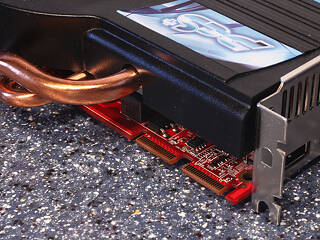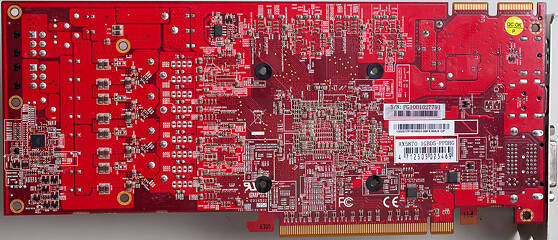 33
33
Powercolor HD 5870 PCS+ Review
(33 Comments) »Introduction

Last year AMD released their new Radeon HD 5800 Series of graphics cards which quickly became a big success due to the numerous improvements made over previous generations. Up to now all cards available from all manufacturers were reference design cards which means they were all made to the same specifications, using the same components and then a sticker was added on the cooler depending on the AIB.
Now Powercolor is one of the first AIBs to release a custom designed HD 5870 card that uses both a non-reference cooler and a non-reference PCB design. While this allows for considerable production optimizations and reduce manufacturing cost it also introduces the risk that the product might not work as optimally as intended by AMD.
Powercolor is actually going beyond the reference design specs and offers higher clock speeds of 875 / 1225 vs. 859 / 1200 on the normal cards. While not making a huge difference it should still give a little extra performance boost to the card.
| Radeon HD 4870 X2 | GeForce GTX 285 | Radeon HD 5850 | Radeon HD 5870 | Powercolor HD 5870 PCS+ | GeForce GTX 295 | |
| Shader units | 2x 800 | 240 | 1440 | 1600 | 1600 | 2x 240 |
| ROPs | 2x 16 | 32 | 32 | 32 | 32 | 2x 28 |
| GPU | 2x RV770 | GT200b | Cypress | Cypress | Cypress | 2x GT200b |
| Transistors | 2x 956M | 1400M | 2154M | 2154M | 2154M | 2x 1400M |
| Memory Size | 2x 1024 MB | 1024 MB | 1024 MB | 1024 MB | 1024 MB | 2x 896 MB |
| Memory Bus Width | 2x 256 bit | 512 bit | 256 bit | 256 bit | 256 bit | 2x 448 bit |
| Core Clock | 750 MHz | 648 MHz | 725 MHz | 850 MHz | 875 MHz | 576 MHz |
| Memory Clock | 900 MHz | 1242 MHz | 1000 MHz | 1200 MHz | 1225 MHz | 999 MHz |
| Price | $350 | $350 | $310 | $400 | $410 | $520 |
Packaging
Powercolor's package uses a clean design which does look a bit dull in my opinion, the front conveys all the important product highlights even though the + on PCS Plus (indicating overclocked) is a bit small.
Contents
You will receive:
- Graphics card
- Driver CD + Quick Install Guide
- DiRT 2 coupon
- CrossFire bridge
- DVI to VGA adapter
The Card
Powercolor's cooler is huge and covers the whole card. You can easily see where the heat pipes are located that help with the heat transfer. However, in my opinion, it can not compete with the looks of AMD's reference design cooler. It should also be noted that the heatpipes add quite a bit of size to the card, which could cause a problem with the side panels in some smaller cases.
Just like the reference design, the card occupies two slots in the system.
The card has two DVI ports, one HDMI port, and one DisplayPort. This is just one of many output configurations that are possible on the new cards, thanks to the overhauled display output logic. Basically the card can drive six TMDS signals that can be combined in any way (a dual-link DVI consumes two TMDS lines).
For HDMI Audio, NVIDIA requires you to feed an external audio source, for example from your motherboard's on-board audio, to the card via SPDIF cable. AMD on the other hand has integrated a sound device inside their GPUs which is the easier solution for most users. Also AMD's integrated sound device has been upgraded to support HDMI 1.3a which includes Dolby TrueHD, DTS-HD, AC-3, DTS and up to 7.1 channel audio with 192 kHz / 24-bit.
Crossfire configurations are supported to improve performance even further.
Here are the front and the back of the card, high-res versions are also available (front, back). If you choose to use these images for voltmods etc, please include a link back to this site or let us post your article.
Our Patreon Silver Supporters can read articles in single-page format.
Apr 15th, 2025 14:59 EDT
change timezone
Latest GPU Drivers
New Forum Posts
- What are you playing? (23381)
- Last game you purchased? (764)
- Is it worth buying a pi5 with a broken hdmi connector (3)
- The TPU UK Clubhouse (26098)
- AAF Optimus Modded Driver For Windows 10 & Windows 11 - Only for Realtek HDAUDIO Chips (397)
- SSD becomes read only and cannot boot, is it dead? (17)
- RX 9000 series GPU Owners Club (322)
- [TechSpot] Breakthrough water filter eliminates forever chemicals using modified graphene oxide (4)
- [Intel AX1xx/AX2xx/AX4xx/AX16xx/BE2xx/BE17xx] Intel Modded Wi-Fi Driver with Intel® Killer™ Features (310)
- Flashing Asus TUF RTX 3080 TI GAMING OC VBIOS to MSI RTX 3080 Ti VENTUS 3X OC (2)
Popular Reviews
- G.SKILL Trident Z5 NEO RGB DDR5-6000 32 GB CL26 Review - AMD EXPO
- ASUS GeForce RTX 5080 TUF OC Review
- Thermaltake TR100 Review
- The Last Of Us Part 2 Performance Benchmark Review - 30 GPUs Compared
- TerraMaster F8 SSD Plus Review - Compact and quiet
- DAREU A950 Wing Review
- Sapphire Radeon RX 9070 XT Pulse Review
- Zotac GeForce RTX 5070 Ti Amp Extreme Review
- Sapphire Radeon RX 9070 XT Nitro+ Review - Beating NVIDIA
- Upcoming Hardware Launches 2025 (Updated Apr 2025)
Controversial News Posts
- NVIDIA GeForce RTX 5060 Ti 16 GB SKU Likely Launching at $499, According to Supply Chain Leak (182)
- NVIDIA Sends MSRP Numbers to Partners: GeForce RTX 5060 Ti 8 GB at $379, RTX 5060 Ti 16 GB at $429 (124)
- Nintendo Confirms That Switch 2 Joy-Cons Will Not Utilize Hall Effect Stick Technology (105)
- Over 200,000 Sold Radeon RX 9070 and RX 9070 XT GPUs? AMD Says No Number was Given (100)
- Nintendo Switch 2 Launches June 5 at $449.99 with New Hardware and Games (99)
- Sony Increases the PS5 Pricing in EMEA and ANZ by Around 25 Percent (85)
- NVIDIA PhysX and Flow Made Fully Open-Source (77)
- NVIDIA Pushes GeForce RTX 5060 Ti Launch to Mid-April, RTX 5060 to May (77)









